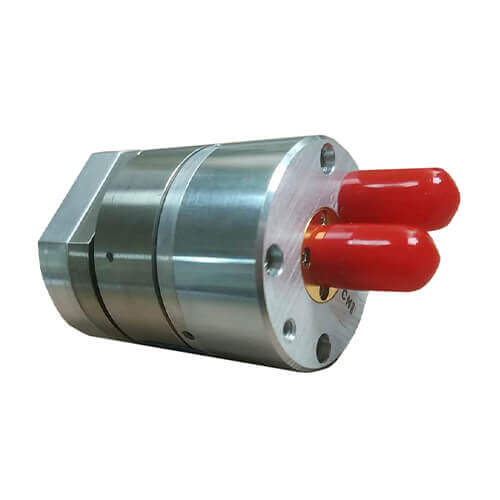In today’s digital era, the role of high-frequency technology has significantly shifted from being a niche application area to the backbone of various sectors. With the increased dependency on technology that operates at high frequencies, we encounter an unsung hero aiding this revolution – the Slip Ring.
Introduction to Slip Ring Applications in High-Frequency Technology
Overview of the Relevance of Slip Rings in High-Frequency Technology
Understanding a Slip Ring’s role first needs an overview of its basic functioning. A Slip Ring, or a rotary electrical interface, allows uninterrupted transmission of power and electrical signals from a stationary platform to a rotating structure. While Slip Rings have been crucial in many areas, their vital importance in high-frequency technology is perhaps one that carries vast potential implications, primarily due to the growing demands of high-speed data transmission and wireless communication applications.
Understanding How Slip Rings Function in High-Frequency Environments
The primary job of a Slip Ring is to ensure reliable transmission of power and signals while coping with the mechanical motion involved. It might seem simple, but this task gets complex when high frequencies come into play. In high-frequency environments, slip rings need to maintain signal integrity and combat interferences that can severely impair system performance. In a high-frequency Slip Ring, power and signals are transmitted via separate conductive paths to avoid interference. Custom materials and unique design elements may also be incorporated into these Slip Rings to carry out transmission without loss or distortion, even at high frequencies.
Highlighting Key Areas of Application and Why It Matters
The applications of high-frequency Slip Rings are vast, underlining their relevance further. Radar and satellite systems, telecommunications, medical technology (such as imaging systems), and even ever-present IoT devices are just a few areas where these Slip Rings play a crucial role. The reliance on these Slip Rings is poised to increase as we progress towards more advanced technologies, thereby demanding high-speed data transmissions and robust wireless connections. Understanding this application spectrum of high-frequency Slip Rings forms a stepping stone toward assessing the growing reliance on this technology aspect and its role in shaping our digital future.

Deep Dive into High-Frequency Slip Rings
As the demand for high-frequency technology intensifies, it is crucial to delve deeper into the nuances of the High-Frequency Slip Rings – understanding how they work, what sets them apart, and their significance in various applications.
Understanding the Principle and Working of Slip Rings in High Frequency
In a high-frequency environment, energy is transmitted in the form of electromagnetic waves across a wide spectrum of frequencies, creating several challenges for effective power and data transmission. High-Frequency Slip Rings are designed to mitigate these challenges and maintain an ideal performance despite the associated mechanical constraints.
The fundamental working principle of a High-Frequency Slip Ring is to allow for the transfer of electrical power and signals from a stationary source to a rotating component, employing separate conductive paths for power and signals to prevent interference. Inside the Slip Ring, conductive rings and brushes facilitate data transmission, utilizing low-resistance materials and specialized designs to minimize contact noise and ensure signal integrity.
Elaborating the Unique Features and Types of High-Frequency Slip Rings
High-Frequency Slip Rings are distinguished by the unique features they possess to combat the challenges of high-frequency environments. These features may include:
- Low electrical noise or contact resistance: Utilizing precious metals or specialized alloys to minimize noise, maintain signal integrity, and prolong service life.
- Shielding: Proper shielding of signal paths or conductive rings to reduce electromagnetic interference (EMI) and enhance signal quality.
- Multiplexers and demultiplexers: Some High-Frequency Slip Rings may incorporate these devices within their design to merge multiple signal channels into a single signal path, ensuring efficient transmission and reducing noise.
Different types of High-Frequency Slip Rings cater to diverse requirements and industries, such as fiber optic Slip Rings (FORJs) for high-speed data transmission, coaxial Slip Rings for Radio Frequency (RF) applications, or even hybrid Slip Rings for combining power, data, and control signals into a single device.
Demonstrating the Impacts of These Slip Rings in Various Applications
High-Frequency Slip Rings have a broad reach, significantly influencing the functionality, efficiency, and reliability of various systems across multiple industries. Some prime examples include:
- Radar systems: The rotation of antennae and consistent high-frequency data transmission are enabled by High-Frequency Slip Rings, making them indispensable for the effectiveness of radar systems.
- Satellite communications: Reliable communication hinges on high-frequency transmission, which is facilitated by these Slip Rings to maintain fluid operational capabilities.
- Medical equipment: For imaging devices like MRI machines, the image quality and diagnostic precision are highly dependent on efficient high-frequency data transmission, achievable through the implementation of High-Frequency Slip Rings.
Understanding the context and the connection between High-Frequency Slip Rings and their applications reinforces their immense importance in multiple sectors and underscores their evolving role in shaping our technological future.
Major Applications Of Slip Rings in High-Frequency Technology
Each sector has unique requirements and standards, but they all require Slip Rings in some capacity for smooth, reliable high-frequency data transmission. This section outlines various applications of Slip Rings across diverse domains.
Slip Rings in Radar Systems

Radar systems, particularly those employed in defense sectors, operate at high frequencies, transmitting data in real time for constant monitoring and surveillance. Here, a Slip Ring’s role is paramount. As radars typically involve rotating antennas, the need for a device that can consistently transmit power and high-frequency signals without interruption is crucial. Slip Rings enable this seamless operation, affecting the accuracy, reliability, and real-time performance of radar systems.
Application in Satellite Communications
Satellite communications heavily depend on high-frequency transmission for data exchange. High-Frequency Slip Rings form a vital link in this chain. Ensuring timely and accurate data transmission can significantly influence the performance of satellite communication systems, making these specialized Slip Rings a non-negotiable component of their operational machinery.
Role in Telecommunication Equipment & Cell Towers
Telecommunication equipment and cell towers handle massive amounts of high-frequency data, impacting daily communications quality. Here, Slip Rings play a dual role. They allow for the rotation of directional antennas for optimized signal broadcasting and facilitate high-speed, consistent data transmission. Thus, the quality of the Slip Ring directly affects the communication system’s reliability and reach.
Critical Use in Medical Equipment

In medical facilities, precision is paramount. Take, for example, MRI machines that heavily rely on high-frequency data transmission. Within these devices, High-Frequency Slip Rings help capture detailed images, facilitating accurate diagnoses and effective treatment plans. Any compromise on the Slip Ring’s performance here can lead to skewed diagnostic outputs, making their role undeniably critical.
Influence on Internet of Things (IoT) devices
IoT devices are shaping a connected world. To maintain this connectivity, high-speed data transmission is essential. High-Frequency Slip Rings can facilitate this communication and power supply to these devices, contributing significantly to the growth and reliability of the IoT network.
Function in High-Speed Data Transmission Systems
High-speed data transmission systems, such as those found in research laboratories and test & measurement equipment, need to maintain high data integrity levels. High-Frequency Slip Rings are crucial here, offering highly reliable, low-noise transmission capabilities that can handle complex high-frequency signals, thus positively influencing overall system performance.
Exploration of Other Relevant Applications
High-Frequency Slip Rings’ potential applications are not just limited to these sectors. They hold relevance in marine and underwater systems, wind energy turbines, security systems, and audio-visual broadcasting equipment, to name a few. Their versatility to cater to different environments and specifications, all while maintaining high-frequency data integrity, truly underlines their utility and relevance in the future of technology infrastructure.
User Concerns about High-Frequency Slip Rings
Though the High-Frequency Slip Rings are a boon to increasingly demanding high-frequency technology applications, potential users often grapple with several concerns about their performance, reliability, cost, and sustainability. This section delves into these concerns and provides a comprehensive understanding of these aspects.
Discussion on Technical Performance Issues
User concerns predominantly begin with questions on technical performance. For example, users may worry about the Slip Ring’s ability to maintain signal integrity at high frequencies, especially in the presence of interference from other signals or power lines. They may also be concerned about how changes in environmental factors (like temperature, dust, and moisture) could impact Slip Ring performance. A key focus for suppliers should be to build Slip Rings that effectively address these concerns, providing reliable and robust performance across varying conditions.
Understanding the Importance of Reliability and Longevity of Slip Rings
The longevity and reliability of the Slip Rings a critical concerns for users as frequent need for replacements will mean recurring expenditure and unintended system downtime. The choice of materials, design efficiency, and performance under testing conditions play a significant role in assuring users of the product’s robustness and reliability over a long lifespan.
Discussing Maintenance Requirements and Replacement
Maintenance and replacement are inevitable aspects of any mechanical device. Users are often worried about the ease, frequency, and cost of maintenance, both preventive and corrective. Ease of replacement is also a concern, as the effort, time, and costs associated with the ring’s replacement could lead to reduced productive time. Providing clear, step-by-step guidance on these aspects could help alleviate many user concerns in this area.
Analyzing Cost Implications: Initial and Life-Cycle Costs
Given the significant role of Slip Rings, financial considerations are high on the list of user concerns. Initial capital outlay, running costs, maintenance, and eventual replacement costs make up the life-cycle cost of the Slip Ring. Understanding these costs helps users plan their resources better and evaluate the cost-benefit trade-off of investing in a particular Slip Ring.
Availability and Relevance of Industry-Specific Slip Rings
The availability and relevance of industry-specific Slip Rings are also a pertinent concern. Users need to be reassured that their specific requirements, whether relating to industry-specific standards or unique use cases, will be met. Manufacturers have to constantly innovate and diversify their offerings, addressing these concerns and delivering customized solutions where generic products fail to meet individual user needs.
Addressing Concerns About Environmental Impact and Sustainability
As sustainability gains prominence, users are increasingly concerned about the environmental impact of the materials and processes used in manufacturing Slip Rings. They may also be interested in the product’s recyclability at the end of its life. Catering to these concerns requires manufacturers to adopt more sustainable practices and use eco-friendly materials where possible, making a conscious effort to reduce their environmental impact while still ensuring high-quality, reliable products.
Informed Decisions about High-Frequency Slip Rings
Making informed decisions about High-Frequency Slip Rings entails understanding the nuances of quality assessment, evaluating cost and performance trade-offs, choosing an apt Slip Ring for a particular application, and considering long-term use and maintenance aspects. Let’s explore these components in greater detail.
Criteria for Assessing the Quality of a Slip Ring
Assessing the quality of a Slip Ring necessitates a review of specific key elements:
- Materials: This includes the quality of conductive metals and shielding materials used, which directly impact the Slip Ring’s performance and lifespan.
- Design: Issues such as the structural integrity of the Slip Ring, its resistance to wear and tear, and its ability to withstand operational stresses are paramount.
- Electrical Performance: This covers parameters such as low electrical noise, reliable signal transmission at high frequencies, and resistance to interference.
- Durability: This refers to how long the Slip Ring can function properly under given operational conditions.
- Testing: The manufacturer’s testing methods and standards also provide insights into the product’s quality.
Trade-Off Between Cost and Performance
Understanding the trade-off between cost and performance is crucial. While cost-effectiveness is a logical goal, the value derived from a high-quality, reliable Slip Ring could exceed its higher initial investment. Users should consider not only the initial purchase price but also costs related to maintenance, replacement parts, and potential downtime due to failures – all of which might occur more frequently with less expensive but low-performance Slip Rings.
Choosing a Suitable Slip Ring for Specific High-Frequency Applications
Choosing a suitable Slip Ring depends upon the specific application’s demands. Key considerations might include the necessary rotational speed, the type and quantity of data to be transmitted, the operational environment, and any industry-specific standards or requirements. It’s advisable to work closely with the supplier or manufacturer, leveraging their expertise to settle on the Slip Ring that best fits your needs.
Considerations for Long-Term Use and Maintenance
Planning for long-term use and maintenance is imperative. High-Frequency Slip Rings will require periodic maintenance to maintain optimal performance over time. Thus, understanding the manufacturer’s maintenance guidelines and ensuring that the necessary resources (spare parts, in-house expertise, etc.) are available could be pivotal. Considering a Slip Ring’s expected lifespan and the ease and cost of its eventual replacement also contribute to making informed, future-proof decisions.
The Future of Slip Rings in High-Frequency Technology
Slip Rings play a central role in modern-day high-frequency applications. Looking towards the horizon, advancements within this technology and the implications of emerging technologies will shape the future of High-Frequency Slip Rings.
Upcoming Advancements and Predictions for Slip Ring Technology
Several technological advancements are under development for Slip Rings that could enhance their performance, longevity, and applications. Miniaturization is one trend increasingly being witnessed, with smaller Slip Rings being more suitable for limited-space applications without compromising on efficiency. Improvements in materials science could deliver Slip Rings with better durability and performance. Predictive maintenance, powered by Machine Learning and AI, could also become a significant feature, enabling more effective planning for maintenance tasks and reducing downtime.
The Implications of New-Age Technologies on Slip Ring Applications
Emerging technologies are not only influencing the evolution of Slip Ring technology, but they are also shaping its applications. New-age technologies like IoT and 5G are paving the way for applications demanding high-frequency data transmission and power supply, where Slip Rings play a crucial role. Furthermore, increasing reliance on renewable energy sources like wind turbines, which require Slip Rings for optimal operation, speaks volumes to their rising importance.
Balancing the Pace of Tech Evolution with the Need for Slip Rings
Despite the rapid shift towards wireless technologies, the demand for Slip Rings in certain applications is unlikely to wane. Many high-frequency applications still need the reliability and efficiency that Slip Rings provide, making it essential to balance the pace of technological evolution with the continued refinement of Slip Ring technology. This balance will ensure that as technology advances, the role of the Slip Ring adapts and evolves too, making it even more integral to high-frequency applications.
FAQs about High-Frequency Slip Rings
To help better understand High-Frequency Slip Rings, it’s essential to address the commonly asked questions and provide concise yet precise explanations. This will aid users in making well-informed decisions and enhance their understanding of both the technology and its applications.
Addressing Widely Asked Questions About High-Frequency Slip Rings
Users might have various questions on topics ranging from the basic functioning of High-Frequency Slip Rings to specifics about materials, applications, and maintenance. By addressing these questions, not only will users be better informed, but manufacturers and suppliers can also better align their offerings to users’ needs.
Commonly asked questions may include:
- What are the main factors affecting the performance of High-Frequency Slip Rings?
- How does the choice of materials impact the longevity and reliability of Slip Rings?
- What factors should be considered when choosing a Slip Ring for a specific high-frequency application?
- How frequently should Slip Rings be maintained, and what are the common maintenance procedures?
- What are the environmental and sustainability concerns associated with Slip Rings, and how can they be mitigated?
Providing Concise and Precise Explanations About the Topic in Question
Giving concise and precise answers to the users’ questions is crucial in fostering understanding and simplifying decision-making. This can be done by focusing on the key aspects of the question, providing relevant examples, and offering actionable advice.
For example, when explaining how the choice of materials impacts Slip Ring reliability, provide specific information about common materials’ suitability, their impact on conductivity and durability, and how the right materials can directly enhance the performance of the Slip Ring.
By addressing FAQs comprehensively, users can better navigate the landscape of High-Frequency Slip Rings, equipping them to make well-informed decisions and ensuring the full potential of this technology is realized.
Conclusion
High-Frequency Slip Rings are a crucial component in modern high-frequency technology applications. This guide has endeavored to provide comprehensive insights into this technology, addressing user concerns, providing guidance on decision-making, and teasing out future trends.
In summary, this guide provides navigational insights into the world of High Frequency Slip Rings. Distilling detailed explanations into concise sections, it addresses common concerns such as reliability, maintenance, cost, and environmental impact. It offers criteria for assessing the quality of Slip Rings, provides guidance on the trade-off between cost and performance, and suggests considerations for long-term use.
Looking towards the future, the guide discusses upcoming advancements, like miniaturization and predictive maintenance, the implications of emerging technologies like IoT and 5G, and predictions of the continued integral need for Slip Rings.
In answering the most frequently asked questions, the guide provides individuals with a clear pathway to increase understanding, assist informed decision-making, and appreciate the value of Slip Rings in high-frequency applications.
Understanding the role, the challenges, and the potential of High-Frequency Slip Rings not only enhances the capability to make more informed decisions but also positions users to utilize this technology to its full potential, whether in the present context or in response to upcoming technological advances.
See What We Can Do

